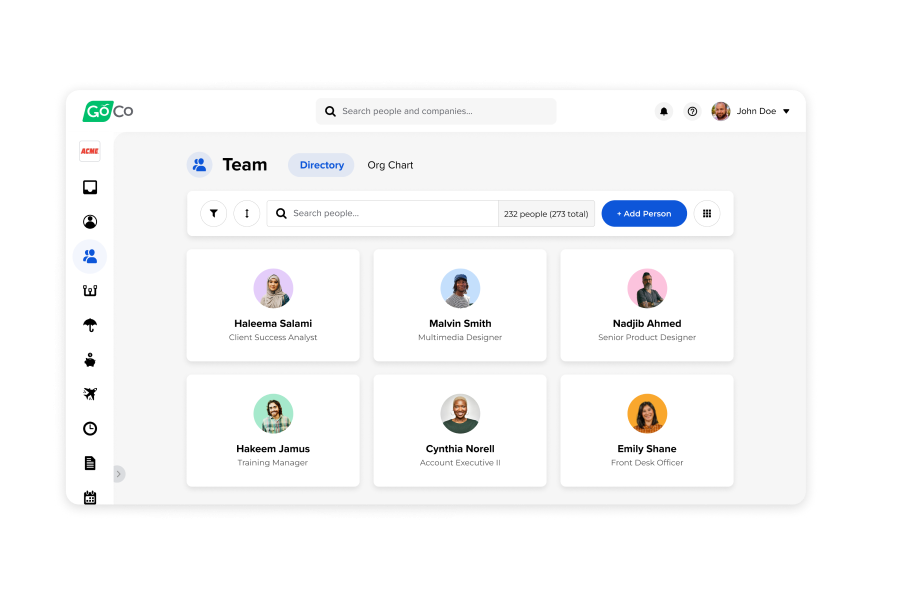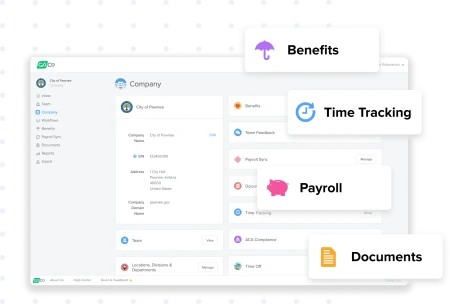18 Tips For Managing Creative People in 2024
Today's workplace is filled with different personality styles. Understanding those differences and how they affect your workforce can make you a more effective manager.
by Nick Schurk - January 5th, 2024
Today's workplace is filled with different personality styles. Understanding those differences and how they affect your workforce can make you a more effective manager. Working with "left-brained" (more analytical) versus "right-brained" (more creative) employees has its own set of rules. Most creative workers use the right-brain style of learning and working, which is a visual, random, emotional, and somewhat impulsive style of learning, according to data compiled at Western Michigan University.
Download The Ultimate Onboarding Checklist
Right-brain people like to work with sound in the background (note all those earbuds around the office), like to move about while thinking about concepts, and generally start with a big idea and narrow it to the details. Left-brained workers are more verbal and logical, like things in order, and prefer a formal workplace. Take a look at your staff. How many right-brain workers are in the room? My guess is the number is pretty high among designers. Here are a few tips for managing your creative people in a way they can relate to.
18 Tips for Motivating and Managing Creative People
1. Change Things Up
Matt Miller from Embroker advises, "Creative people are extremely serious about their work, but in order to manage them, you need to fulfill their need to be surprised. Nothing is more disruptive to a creative personality than boredom, and repeating the same process over and over again or taking on the same tasks can quickly make them lose interest.
"Therefore, it is important to constantly change things up by giving them complex tasks, providing loose guidelines in which they must figure out solutions, and encouraging them to come up with more than one answer to a problem. By approaching them in this manner, you will be tying into the part of their brain that seeks this change to remain motivated. In this constant change, you can find the secret of managing your creative people."
2. Build Repeatable Standard Operating Procedures
Kristine Thorndyke of Test Prep Nerds says, "I manage several writers for my blog and each of their writing tasks is part of a clear SOP that lists out each step of the writing and publishing process. Within their writing task, I do my own research of what specifically I want to be included in an article, such as headers, keywords, and FAQ sections, and then allow them the creativity and flexibility to work within those boundaries. This helps to keep our writing and publishing process extremely organized and effective and gives the creative writers room to build out the content to their liking, within the specified constraints."
3. Encourage Collaboration
Abe Breuer of VIP To Go suggests, "Encourage brainstorming sessions among creatives. Give them the freedom to share ideas with one another without the need for facilitation from you. Creatives will feel comfortable because it will give them a safer space to express concepts openly with people they share similarities with. Allowing creatives to brainstorm with one another builds teamwork. To ensure that discussions will be productive, instruct the team to present their ideas to you."
4. Shift Away from Linear Management
Clare Jones of OfficeSpaceAU recalls, "As someone who classes themselves as more of an analytical person, I initially found it difficult to manage creative members of my team. This largely stemmed from the way in which many creatives often find themselves jumping from idea to idea, rarely working in a linear manner before eventually settling on a finished product. One tip that I would give to anyone looking to manage creative people is to embrace this creativity by creating an environment in which experimentation is encouraged and management input serves as a subtle guide rather than a linear path.
"In my experience, allowing creatives to find the best way forward and supporting them with constructive feedback or an alternative perspective often leads to excellent results. Staying away from a linear management style also promotes innovation and personal development, providing employees with the opportunity to find new passions and explore new areas that could potentially benefit the business moving forward."
5. Show Them How They Fit into the Big Picture
Sam Speller of Kenko Matcha advises, "To effectively manage creative people, make sure everyone understands how their work fits into the bigger picture of the project. Creative people value being a part of something bigger, and this motivates them to apply their creativity toward the team's goals. Also, don't forget to reward good work! Gratitude goes a long way in motivating creative people, so make sure you show appreciation regularly to each team member for their wins, big and small."
6. Maintain the Trust Between Left and Right-Brainers
Monte Deere of Kizik suggests, "Don’t be afraid to fail. Our analytical sides use logic and data to avoid failure, but projects that rely on creative solutions often can’t use logic to justify their decisions. Giving creative people the leeway to do their best combined with your analytical guidance sets everyone up for success, so long as trust in each other’s opinions remains. If right-brain solutions don’t result in success, it’s up to management to not lose faith in these creative team members and set unhelpful restraints. If you don’t let the creative team do their job, they won’t trust that the analytic managers are doing theirs."
7. Use the Socratic Method
Melanie Peacock of Double M Training & Consulting recommends, "Ask a lot of questions. Seek to understand their thought processes, reasons for decisions, and approaches to work. Dialogues such as this present an opportunity for both parties to learn in lieu of feeling threatened or devalued. Query-based conversations allow people to better comprehend that others view the world, and our interactions in it, from varied perspectives."
8. Lead With What Success Looks Like, Not How to Get There
Kelly Skelton of Backyard Assist says, "When managing creative people, it's most effective to tell them the end result (what success looks like) and then back off. I've found that creative people hate micromanagement, so if you allow them to find the best way to achieve a well-defined outcome, we left-brain managers get what we ultimately want, and they feel they're able to be creative and autonomous while getting there.
"Example: "We need to improve conversion on this lead generation ad from 10 - 20%." There are so many things a creative person could do to achieve this goal. They could change imagery, target audience, landing page copy, and ad copy - the possibilities are endless. Saying something like "I think you should tweak the ad's image, I think that's what'll get us to 20%" is not what a creative person will respond best to."
9. Develop Ideas
Start with a collaborative environment. Work with creative people to develop concepts but avoid specific, detailed instructions on what a project should look like. Explain parameters clearly – such as the feel or look a project should have – and let the designer go to work. Check in often to see how the project is going and help in its development.
The creative personality is not one to just follow a set of rules; that is one trait that makes them successful in creative and design-oriented fields. Give them room to develop concepts without constant observation.
Coach workers rather than dictate a set of rules to them. Avoid planning out everything that should be done in advance; give employees the freedom to make choices so they feel some creative control over projects.
10. Brainstorm, Brainstorm, Brainstorm
Much of the creative process is organic, and creative people like to think and imagine. Because a characteristic of a right-brained thinker is to process information in sometimes random and varied orders, brainstorming sessions can be beneficial. Toss out many ideas (follow the "no idea is stupid" rule) and keep quick notes of concepts that are workable.
Encourage workers to brainstorm with each other. You don't have to be present for good ideas to emerge. Tracy Collins, a newspaper manager, offered this advice in the 2008 edition of Design Journal: "Help them develop brainstorming alliances that will strengthen teamwork within the visual group, and have that group present their ideas to you."
11. Foster a Creative Workspace
A row of gray cubicles will not foster creativity. Litter your workspace with color and items that will inspire workers. Look for interesting artwork or showcase some of the work your company has done. Is the room silent? Think about playing music at a certain time of day. Let the employees pick the tunes.
Rearrange the workspace to facilitate communication and collaboration. Paint a white wall orange and add a piece of artwork to it. Set aside an area with couches and tables for employees to relax and chat. One of the world's top companies, Google, is known for its super-modern workspaces, which feature lots of colors and modern "cubicles."
Be flexible with work schedules if possible. Maybe some of your workers would benefit from a schedule that does not fit in the 9-to-5 mold. Try to accommodate shift variances for people to optimize their skills.
12. Provide Regular Feedback
Let your employees know how they are doing. It is easy for someone who primarily uses a right-brained style of thinking to become attached to their work emotionally. During critiques, keep the focus on an employee's work. Choose words carefully.
In any creative field, much of what "works" or does not can be a matter of personal preference. Weigh this when critiquing a project. If you do not like a creative piece look, ask yourself several questions. Does it work for what the client wants? Does it follow our guidelines of style, and is it technically sound?
If the project meets these guidelines and you still don't like it, the difference may just be a matter of taste. Remember, you may not like everything that comes across your desk. It may sound overly simple but people have different styles and like different things. It does not make something right or wrong; it is just a matter of taste.
Do set clear boundaries in black-and-white areas. A common concern among creatives, for example, can be meeting deadlines. Start with how much you like the project's direction but emphasize that the team is waiting for everyone's contribution so the project can be completed. Outline a clear set of steps to meet that goal.
13. Develop Style Parameters
Although creative workers like their space, it is a good idea to have some guidelines in place. Develop and post set technical specifications, communication standards, and deadline policies.
For certain types of work where visual consistency is important -- such as the design in magazines, newspapers, and some websites -- develop a basic set of style rules. Outline what fonts and colors are acceptable; set guidelines for images. Also set guidelines for breaking the rules -- what is the threshold, and who approves the "rule-breaking."
14. Don't Fear Failure
An international Mercedes-Benz ad campaign in early 2011, focused on left and right brain traits in a series of print advertisements. These ads showed the differences in thinking styles visually. The result was visually stunning images that make you think, but did they sell the product described? The creative agency took quite a risk with this edgy campaign, but I doubt people who saw the ad related it to buying a car. The result could be viewed as both a success and a failure.
Don't take away work from someone after a failed project. That is the time to "get back on the bike" and try something else. If an employee did good work but a project just did not come together, give them another chance and talk about the small successes and failures that contributed to the final result. Creative people can have big egos at times and need to feel some success to find continued success.
15. Coach Principles of Communication
Sometimes it can be very frustrating for visual people to communicate with non-visual workers. Your visual group may be able to "see" an idea during a conversation while others cannot. Coach those workers on how to better communicate their ideas.
Sometimes the solution can be as simple as having sketch pads and pens at all meetings so those visual ideas can be put out there for everyone. Ask questions to help visual thinkers learn to better articulate their thoughts as well: "I don't understand. Please talk me through this one more time."
Help designers learn to explain their decision-making and why things look a certain way. Don't accept "because it looks cool" as an answer; push creatives to justify the reasons why something works or does not.
16. Emphasize That Different is Good
Don't focus on differences as a negative attribute; use them to your team's advantage. Different styles of thinking and communication can be a challenge in the workplace, but try to focus on how to use those differences.
Creative people think in a way that is likely to challenge the more structured thought process of managers. Keep your cool during these challenges. It may be frustrating, but the same thought process that challenges your rules about a dress code is the same process that got you stellar results on a project. Learn to mesh your styles effectively but keep lines of communication open and appreciate differences.
Want even More HR Goodness? Sign up now to receive the latest HR tips and GoCo updates straight to your inbox!
17. Emphasize Learning
Technology is changing the way we work each day at a pace that is hard to match. Make sure your employees are learning new things and keeping up.
Print designers should be dabbling in web design. Encourage and find opportunities for those who are not. Web designers should have to participate in a print project or two.
Provide learning materials for your staff as well. Subscribe to industry magazines and have them available. Send links to neat ideas or online articles. Show that you are seeking out learning opportunities as well.
18. Start Daydreaming
Daydreaming is at the core of problem-solving, according to an article by Amy Fries for Psychology Today. Don't stop your best employees when they zone out at their desks; sometimes, that is when the creative process is happening.
Further, encourage mental time-outs. Several companies known for innovation – Google, 3M, and Gore-Tex – offer employees free time just to sit and think. When have your best ideas hit – in the shower, at the dinner table? Giving employees more time to think about projects may increase overall productivity.
Conclusion
Managing creative people is no simple task. There are no perfect ways to keep everyone happy and productive. But as a manager, you can create workspaces and environment that fosters out-of-the-box thinking.
The keys to success are understanding how creative people operate (the room may be filled with right-brained thinkers), constant communication, and freedom to let people do what they do best. You might have to get out of your comfort zone to do it, but push some of the boundaries to create a space that encourages this open exchange and see where it takes your group.
Gone are the days of the dreaded annual performance review. Discover how GoCo's modern HR software can help you have better one-on-ones to keep your employees engaged and retain top talent.
Updated 1/5/2024

Subscribe to Beyond The Desk to get insights, important dates, and a healthy dose of HR fun straight to your inbox.
Subscribe hereRecommended Posts
How To Retain Employees In 2023: 15 Strategies For HR
Blog Articles
23 Incentive Programs That Employees Love
Blog Articles
22 Employee Engagement Ideas That Remote Workers Love
Blog Articles
Search...
Product
GoCo
Resources
Articles
eBooks
Webinars
Customer Stories





